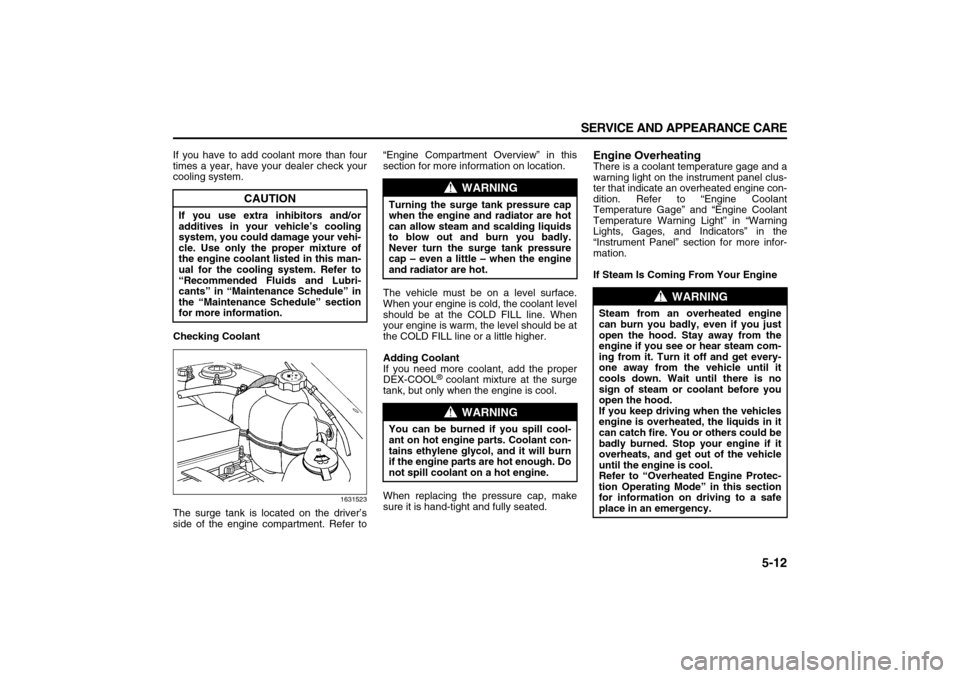radiator cap SUZUKI XL7 2007 2.G Owners Manual
[x] Cancel search | Manufacturer: SUZUKI, Model Year: 2007, Model line: XL7, Model: SUZUKI XL7 2007 2.GPages: 274, PDF Size: 6.12 MB
Page 196 of 274

5-12 SERVICE AND APPEARANCE CARE
78J00-03E
If you have to add coolant more than four
times a year, have your dealer check your
cooling system.
Checking Coolant
1631523
The surge tank is located on the driver’s
side of the engine compartment. Refer to“Engine Compartment Overview” in this
section for more information on location.
The vehicle must be on a level surface.
When your engine is cold, the coolant level
should be at the COLD FILL line. When
your engine is warm, the level should be at
the COLD FILL line or a little higher.
Adding Coolant
If you need more coolant, add the proper
DEX-COOL
® coolant mixture at the surge
tank, but only when the engine is cool.
When replacing the pressure cap, make
sure it is hand-tight and fully seated.
Engine OverheatingThere is a coolant temperature gage and a
warning light on the instrument panel clus-
ter that indicate an overheated engine con-
dition. Refer to “Engine Coolant
Temperature Gage” and “Engine Coolant
Temperature Warning Light” in “Warning
Lights, Gages, and Indicators” in the
“Instrument Panel” section for more infor-
mation.
If Steam Is Coming From Your Engine
CAUTION
If you use extra inhibitors and/or
additives in your vehicle’s cooling
system, you could damage your vehi-
cle. Use only the proper mixture of
the engine coolant listed in this man-
ual for the cooling system. Refer to
“Recommended Fluids and Lubri-
cants” in “Maintenance Schedule” in
the “Maintenance Schedule” section
for more information.
WARNING
Turning the surge tank pressure cap
when the engine and radiator are hot
can allow steam and scalding liquids
to blow out and burn you badly.
Never turn the surge tank pressure
cap – even a little – when the engine
and radiator are hot.
WARNING
You can be burned if you spill cool-
ant on hot engine parts. Coolant con-
tains ethylene glycol, and it will burn
if the engine parts are hot enough. Do
not spill coolant on a hot engine.
WARNING
Steam from an overheated engine
can burn you badly, even if you just
open the hood. Stay away from the
engine if you see or hear steam com-
ing from it. Turn it off and get every-
one away from the vehicle until it
cools down. Wait until there is no
sign of steam or coolant before you
open the hood.
If you keep driving when the vehicles
engine is overheated, the liquids in it
can catch fire. You or others could be
badly burned. Stop your engine if it
overheats, and get out of the vehicle
until the engine is cool.
Refer to “Overheated Engine Protec-
tion Operating Mode” in this section
for information on driving to a safe
place in an emergency.
Page 198 of 274

5-14 SERVICE AND APPEARANCE CARE
78J00-03E
C. Pressure Cap
If the coolant inside the coolant recovery
tank is boiling, do not do anything else until
it cools down. The vehicle should be
parked on a level surface.
When the engine is cold, the coolant level
should be at or above the cold fill line on
the coolant recovery tank. If it is not, there
may be a leak at the pressure cap or in the
radiator hoses, heater hoses, radiator,
water pump, or somewhere else in the
cooling system.If there seems to be no leak, with the
engine on, check to see if the electric
engine cooling fans are running. If the
engine is overheating, the fans should be
running. If the fans are not running, the
vehicle needs service.How to Add Coolant to the Coolant
Recovery Tank
If you have not found a problem yet, but
the coolant level is not at the cold fill line,
add a 50/50 mixture of clean, drinkable
water and DEX-COOL
® engine coolant at
the coolant recovery tank. Refer to “Engine
Coolant” in this section for more informa-
tion.
WARNING
An electric engine cooling fan under
the hood can start up even when the
engine is not running and can injure
you. Keep hands, clothing, and tools
away from any underhood electric
fan.
WARNING
Heater and radiator hoses, and other
engine parts, can be very hot. Do not
touch them. If you do, you can be
burned.
Do not run the engine if there is a
leak. If you run the engine, it could
lose all coolant. That could cause an
engine fire, and you could be burned.
Get any leak fixed before you drive
the vehicle.
CAUTION
Engine damage from running your
engine without coolant is not covered
by your warranty. Refer to “Over-
heated Engine Protection Operating
Mode” in this section for information
on driving to a safe place in an emer-
gency.
CAUTION
Using coolant other than DEX-COOL
®
may cause premature engine, heater
core, or radiator corrosion. In addi-
tion, the engine coolant could require
changing sooner, at 30000 miles
(50000 km) or 24 months, whichever
occurs first. Any repairs would not be
covered by your warranty. Always
use DEX-COOL
® (silicate-free) cool-
ant in your vehicle.
WARNING
Adding only plain water to your cool-
ing system can be dangerous. Plain
water, or some other liquid such as
alcohol, can boil before the proper
coolant mixture will. Your vehicle’s
coolant warning system is set for the
proper coolant mixture. With plain
water or the wrong mixture, your
engine could get too hot but you
would not get the overheat warning.
Your engine could catch fire and you
or others could be burned. Use a 50/
50 mixture of clean, drinkable water
and DEX-COOL
® coolant.
CAUTION
In cold weather, water can freeze and
crack the engine, radiator, heater
core and other parts. Use the recom-
mended coolant and the proper cool-
ant mixture.
Page 199 of 274

5-15 SERVICE AND APPEARANCE CARE
78J00-03E
When the coolant level in the coolant
recovery tank is at the cold fill line, start the
vehicle.
If the overheat warning continues, there is
one more thing you can try. You can add
the proper coolant mixture directly to the
radiator, but be sure the system is cool
before you do it.How to Add Coolant to the Cooling Sys-
tem
809006
1) You can remove the pressure cap
when the cooling system, including the
pressure cap and upper radiator hose
is no longer hot. Turn the pressure cap
slowly counterclockwise.
If you hear a hiss, wait for that to stop.
A hiss means that there is still some
pressure left.2) Then keep turning the pressure cap
and remove it.
3) Fill the cooling system with the proper
DEX-COOL
® coolant mixture, up to the
base of the filler neck. Refer to “Engine
Coolant” in this section for more infor-
mation about the proper coolant mix-
ture.
4) Rinse or wipe any spilled coolant from
the engine and the compartment.
1631525
5) Then fill the coolant recovery tank to
the cold fill line.
WARNING
You can be burned if you spill cool-
ant on hot engine parts. Coolant con-
tains ethylene glycol and it will burn
if the engine parts are hot enough. Do
not spill coolant on a hot engine.
WARNING
Steam and scalding liquids from a
hot cooling system can blow out and
burn you badly. They are under pres-
sure, and if you turn the radiator
pressure cap – even a little – they can
come out at high speed. Never turn
the cap when the cooling system,
including the radiator pressure cap,
is hot. Wait for the cooling system
and radiator pressure cap to cool if
you ever have to turn the pressure
cap.
CAUTION
Your engine has a specific cooling
system drain and fill procedure. Fail-
ure to follow this procedure could
cause your engine to overheat and be
severely damaged. If your engine’s
cooling system needs to be drained
and re-filled, please see your dealer.
WARNING
You can be burned if you spill cool-
ant on hot engine parts. Coolant con-
tains ethylene glycol and it will burn
if the engine parts are hot enough. Do
not spill coolant on a hot engine.
Page 246 of 274

6-4 MAINTENANCE SCHEDULE
78J00-03E
Service Instruction Maintenance I Maintenance II
Inspect engine air cleaner fil-
ter. If necessary, replace filter. Refer to “Engine Air Cleaner/Filter” in “Checking Things Under the
Hood” in the “Service and Appearance Care” section.
If you drive regularly under dusty conditions, inspect the filter at
each engine oil change.•
Inspect suspension and steer-
ing components. Visually inspect front and rear suspension and steering system for
damaged, loose, or missing parts, signs of wear.
Inspect power steering cables for proper hook-up, binding,
cracks, chafing, etc. (if equipped).•
Inspect engine cooling sys-
tem. Visually inspect hoses and have them replaced if they are
cracked, swollen, or deteriorated.
Inspect all pipes, fittings and clamps; replace parts as needed.
To help ensure proper operation, a pressure test of the cooling
system and pressure cap and cleaning the outside of the radiator
and air conditioning condenser is recommended at least once a
year.•
Inspect wiper blades. Visually inspect wiper blades for wear or cracking.
Replace wiper blades that appear worn or damaged or that streak
or miss areas of the windshield.•
Inspect restraint system com-
ponents. Make sure the safety belt reminder light and all your belts, buck-
les, latch plates, retractors, and anchorages are working properly.
Look for any other loose or damaged safety belt system parts.
If you see anything that might keep a safety belt system from
doing its job, have it repaired.
Have any torn or frayed safety belts replaced.
Also look for any opened or broken airbag coverings, and have
them repaired or replaced.
The airbag system does not need regular maintenance.•
Page 249 of 274

6-7 MAINTENANCE SCHEDULE
78J00-03E
Service InstructionMiles (Kilometers)
25000
(40000)50000
(80000)75000
(120000)100000
(160000)125000
(200000)150000
(240000)
Engine cooling system service (or
every five years, whichever occurs
first). An Emission Control Ser-
vice. Drain, flush, and refill cooling
system.
This service can be complex;
you should have your dealer
perform this service.
Refer to “Engine Coolant” in
“Checking Things Under the
Hood” in the “Service and
Appearance Care” section for
what to use.
Inspect hoses.
Clean radiator, condenser, pres-
sure cap, and filler neck.
Pressure test the cooling system
and pressure cap.•
Inspect engine accessory drive
belt. An Emission Control Service. Visually inspect belt for fraying,
excessive cracks, or obvious
damage.
Replace belt if necessary.•
Page 251 of 274

6-9 MAINTENANCE SCHEDULE
78J00-03E
Service Instruction Maintenance
Inspect engine air cleaner fil-
ter. If necessary, replace filter. Refer to “Engine Air Cleaner/Filter” in “Checking Things Under the Hood” in the
“Service and Appearance Care” section.
If you drive regularly under dusty conditions, inspect the filter at each engine oil
change.•
Inspect suspension and steer-
ing components. Visually inspect front and rear suspension and steering system for damaged, loose,
or missing parts, signs of wear.
Inspect power steering cables for proper hook-up, binding, cracks, chafing, etc.
(if equipped).•
Inspect engine cooling sys-
tem. Visually inspect hoses and have them replaced if they are cracked, swollen, or
deteriorated.
Inspect all pipes, fittings and clamps; replace parts as needed.
To help ensure proper operation, a pressure test of the cooling system and pres-
sure cap and cleaning the outside of the radiator and air conditioning condenser is
recommended at least once a year.•
Inspect wiper blades. Visually inspect wiper blades for wear or cracking.
Replace wiper blades that appear worn or damaged or that streak or miss areas of
the windshield.•
Inspect restraint system com-
ponents. Make sure the safety belt reminder light and all your belts, buckles, latch plates,
retractors, and anchorages are working properly.
Look for any other loose or damaged safety belt system parts.
If you see anything that might keep a safety belt system from doing its job, have it
repaired.
Have any torn or frayed safety belts replaced.
Also look for any opened or broken airbag coverings, and have them repaired or
replaced.
The airbag system does not need regular maintenance.•
Page 254 of 274

6-12 MAINTENANCE SCHEDULE
78J00-03E
Service InstructionKilometers
40000 80000 120000 160000 200000 240000
Engine cooling system service (or
every five years, whichever occurs
first). An Emission Control Ser-
vice. Drain, flush, and refill cooling
system.
This service can be complex;
you should have your dealer
perform this service.
Refer to “Engine Coolant” in
“Checking Things Under the
Hood” in the “Service and
Appearance Care” section for
what to use.
Inspect hoses.
Clean radiator, condenser, pres-
sure cap, and filler neck.
Pressure test the cooling system
and pressure cap.•
Inspect engine accessory drive
belt. An Emission Control Service. Visually inspect belt for fraying,
excessive cracks, or obvious
damage.
Replace belt if necessary.•